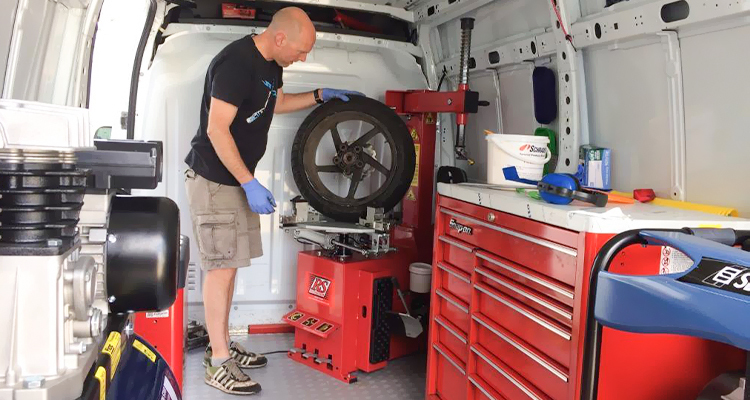Tire Solution: Proven Techniques for Ideal Tire Maintenance and Treatment
Preserving optimal tire problem is extremely important for both security and performance of any vehicle. From ensuring correct tire pressure to regular turning and positioning, there are proven approaches that can dramatically prolong the lifespan of your tires and boost general driving experience. As we explore the details of tire treatment and maintenance, we will certainly uncover crucial standards that every automobile owner must comply with for the ideal possible outcomes. Let's look into the world of tire service and uncover the keys to keeping your tires in superior shape for the lengthy haul.
Significance of Tire Stress
Correct tire pressure is an important consider guaranteeing ideal lorry performance and safety when traveling. Preserving the advised tire pressure levels offered by the maker uses numerous benefits. First of all, ample tire pressure advertises much better gas efficiency, as under-inflated tires can bring about increased rolling resistance, causing the engine to work more difficult and consume more fuel. Second of all, right tire pressure makes sure even tread wear, enhancing tire longevity and conserving cash over time by delaying the need for premature replacements. Furthermore, correctly inflated tires add to boosted handling and stopping capacities, vital for secure driving in numerous road conditions. Over-inflated tires, on the various other hand, can cause lowered grip and a harsher experience. Conversely, under-inflated tires are prone to getting too hot, which can cause accidents and blowouts. On a regular basis inspecting and readjusting tire pressure, especially soon journeys, is a simple yet reliable way to boost vehicle efficiency, prolong tire life-span, and focus on safety when traveling.
Tire Turning Standards
When considering tire rotation guidelines, it is vital to comprehend the relevance of this maintenance task in maximizing tire life expectancy and preserving optimal automobile efficiency. Tire rotation involves transforming the placement of each tire on a vehicle to make certain also tread wear. Front tires have a tendency to use extra quickly than back tires due to steering forces, making normal turning vital for well balanced wear patterns. The suggested turning pattern differs depending on whether an automobile is front-wheel, rear-wheel, all-wheel, or four-wheel drive. Typically, tires ought to be revolved every 5,000 to 7,500 miles, or as encouraged in the car handbook. Disregarding tire turning can result in unequal wear, impacting handling, traction, and potentially compromising vehicle safety. By adhering to correct rotation standards, vehicle drivers can extend the life of their tires, boost fuel performance, and improve overall driving experience. Routine turning is a straightforward yet efficient upkeep method that adds substantially to tire durability and car performance.

Advantages of Wheel Alignment
Ensuring appropriate wheel placement after tire turning is essential for keeping balanced wear patterns and optimizing car efficiency. In addition, appropriate wheel positioning helps to prolong the lifespan of your tires. Misaligned wheels can create uneven tire wear, leading to early tire replacement and raised upkeep expenses.

Tire Footstep Deepness Inspect
Carrying out a normal assessment of tire walk deepness is necessary for keeping safe driving problems and prolonging the lifespan of your tires. Unequal tread wear can indicate issues with tire suspension, stress, or placement, highlighting the importance of routine step deepness checks. By integrating tire tread depth checks visit into your routine maintenance routine, you can drive with confidence understanding that your tires are in top condition.
Seasonal Tire Evaluation
An extensive evaluation of tire condition customized to specific weather is essential for maintaining optimal efficiency and safety and security throughout the year. Seasonal tire assessment is a basic aspect of tire maintenance that makes certain tires are ready to encounter the challenges presented by various climate condition. In preparation for winter, it is necessary to inspect the tire stress routinely as cool temperatures can create tire pressure to go down. Checking tire walk depth is also essential to make sure adequate traction on snow and ice-covered roads. In addition, examining for indicators of damage, such as lumps or splits, can aid protect against potential tire failures. As the seasons change, it is crucial to analyze tire condition and make any kind of required modifications to guarantee risk-free driving. By conducting regular seasonal tire evaluations, drivers can extend tire life-span, enhance gas effectiveness, and most notably, ensure a secure driving experience in varying weather - Mobile Tire Service Las Vegas.
Verdict
In conclusion, preserving proper tire stress, revolving tires frequently, straightening wheels Website properly, monitoring step depth, and conducting seasonal inspections are essential methods for optimum tire treatment. By following these confirmed techniques, vehicle drivers can guarantee their tires last longer, carry out better, and add to total lorry security. It is essential to prioritize tire upkeep to stop crashes, enhance fuel efficiency, and extend the life expectancy of tires.
Adequate tire pressure advertises better gas efficiency, as under-inflated tires can lead to enhanced he said rolling resistance, triggering the engine to work more challenging and eat even more fuel.When taking into consideration tire rotation guidelines, it is important to understand the value of this upkeep task in maximizing tire life expectancy and maintaining optimal lorry performance. Seasonal tire inspection is a basic aspect of tire upkeep that makes sure tires are all set to deal with the obstacles postured by different weather problems. By conducting routine seasonal tire inspections, vehicle drivers can lengthen tire lifespan, improve fuel effectiveness, and most notably, guarantee a safe driving experience in differing weather condition conditions.
In final thought, maintaining appropriate tire stress, rotating tires frequently, straightening wheels appropriately, keeping track of step deepness, and performing seasonal inspections are crucial methods for optimum tire care.